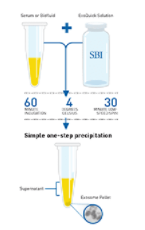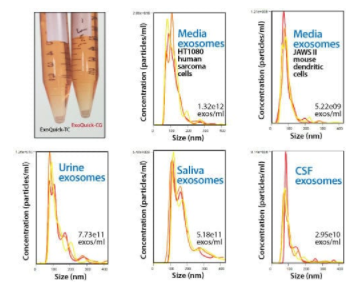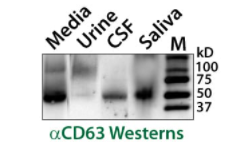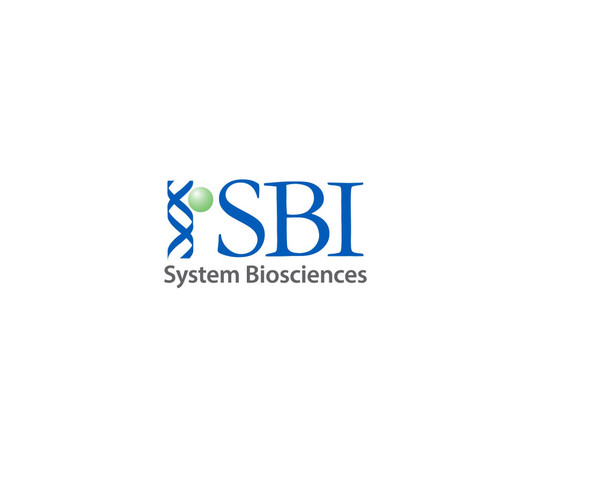System Biosciences
ExoQuick-CG cGMP-grade Exosome Isolation reagent (50 ml)
- SKU:
- EXOCG50A-1
- Availability:
- Usually Shipped in 5 Working Days
- Size:
- 50 ml
- Shipping Temperature:
- RT or Blue Ice
Description
ExoQuick-CG cGMP-grade Exosome Isolation reagent (50 ml). Cat# EXOCG50A. Supplier: SBI System Biosciences

Overview
ExoQuick-CG: cGMP quality exosome isolation for pre-clinical applications
"We therefore pursued the ExoQuick® method for further study, as these samples required much less sample input, a key benefit when working with clinical samples and mouse models1."
Based on SBI’s well-regarded ExoQuick-TC, SBI's ExoQuick-CG exosome precipitation reagent makes miRNA and protein biomarker discoveries simple, reliable, and quantitative. Enrich for exosomal miRNAs with ExoQuick-CG and accurately profile them using SBI's SeraMir qPCR arrays. Downstream protein analysis is also possible with SBI's exosome specific antibodies and ELISA kits.
Enjoy the same benefits of ExoQuick-TC as well as these additional benefits:
- 21 CFR 820 compliant
- All ingredients sourced from GMP manufacturer
- Reagent mixed under cGMP conditions at GMP facility
- Triple filtered
- Sterility tested
- Works in all biofluids tested
Like ExoQuick-TC, ExoQuick-CG enables high-throughput, quantitative isolation of exosomes from most biofluids. Compatible with a wide variety of downstream applications, ExoQuick-CG is an effective and proven alternative to ultracentrifugation1-3.
Choose the right ExoQuick for your application:

REFERENCES
Chugh PE, et al. Systemically Circulating Viral and Tumor-Derived MicroRNAs in KSHV-Associated Malignancies. PLoS Pathog. 2013.
9
(7): e1003484. PMCID: PMC3715412.
Umezu T, et al. Leukemia cell to endothelial cell communication via exosomal miRNAs. Oncogene. 2013 May 30.
32
(22):2747-55. PMID: 22797057.
Sohel MM, et al. Exosomal and Non-Exosomal Transport of Extra-Cellular microRNAs in Follicular Fluid: Implications for Bovine Oocyte Developmental Competence. PLoS One. 2013 Nov 4.
8
(11):e78505. PMCID: PMC3817212.
How It Works
High-throughput, quantitative exosome recovery
Just as with ExoQuick-TC, ExoQuick-CG can be used to purify exosomes from saliva1, urine2, follicular fluid3, tissue culture media4, and breast milk5. With a simple workflow involving minimal hands-on time and low input sample volume requirements, ExoQuick-CG is an excellent option for researchers who need to purify exosomes for pre-clinical, in vivo studies.
To isolate exosomes from cleared serum, plasma, or ascites fluid, simply:
- Add an appropriate volume of ExoQuick-CG
- Incubate for at least one hour at 4°C
- Isolate exosomes with a 30-minute low-speed spin (1500 g).
Isolated exosomes can be found in the pellet and resuspended in an appropriate solution.

You can verify the presence of exosomes with a number of different methods, including Western blotting for general exosome markers (CD63, CD9, CD81, and HSP70), NanoSight analysis, or EM (learn about different ways to detect exosomes and more in our Exosome Basics Guide).
The Bottom Line
With ExoQuick, you can obtain high-quality exosomes from most biofluids using a protocol that can easily be performed on multiple samples and requires very low volumes of input sample.
REFERENCES
Yang J, et al. Detection of Tumor Cell-Specific mRNA and Protein in Exosome-Like Microvesicles from Blood and Saliva. PLoS ONE. 2014. 9(11): e110641. PMCID: PMC 4232306.
Alvarez ML. Isolation of urinary exosomes for RNA biomarker discovery using a simple, fast, and highly scalable method. Methods Mol Biol. 2014. 1182:145-70. PMID: 25055908.
Sohel MM, et al. Exosomal and Non-Exosomal Transport of Extra-Cellular microRNAs in Follicular Fluid: Implications for Bovine Oocyte Developmental Competence. PLoS One. 2013 Nov 4. 8(11):e78505. PMCID: PMC3817212.
Zhu L, et al. Novel method for extracting exosomes of hepatocellular carcinoma cells. World J Gastroenterol. 2014 June 7. 20(21): 6651-6657. PMCID: PMC4047354.
Gu Y, et al. Lactation-Related MicroRNA Expression Profiles of Porcine Breast Milk Exosomes. PLoS ONE. 2012. 7(8): e43691. PMCID: PMC3427246.
Supporting Data
ExoQuick-CG Supports Exosome Isolation from a Wide Range of Biofluids
With ExoQuick-CG, you can quickly and easily isolate high yields of exosomes using cGMP-grade reagents for any downstream application.

Exosome Size Distribution and Yields Using ExoQuick-CG
NanoSight analysis shows ExoQuick-CG isolates high concentrations of exosomes from a variety of biofluids, and that the isolated exosomes are in the expected size range (Figure 1).

Figure 1. 3.3 mL of ExoQuick-CG was combined with 10 mL of conditioned media from either Human HT1080 lung sarcoma cells or Mouse JAWS II dendritic cells that had been cultured in Exo-FBS (exosome depleted FBS medium supplement, catalog # EXO-FBS-50A-1). All samples were incubated overnight at 4°C for exosome precipitation. Exosomes were resuspended in 0.5 mL of PBS and visualized on a NanoSight LM10 instrument.
Exosome CD63 Western Blot Validation Studies
Western blotting of the ExoQuick-CG-isolated particles using an exosome-specific antibody (anti-CD63) further validates that the particles isolated with ExoQuick-CG are exosomes (Figure 2).

Figure 2. Approximately 10-50 µg of exosomes from the NanoSight studies shown in Figure 1 were separated via denaturing SDS PAGE for Western blot analysis. CD63 protein was detected using SBI’s rabbit anti-CD63 primary antibody and SBI’s HRP-conjugated secondary goat anti-rabbit antibody (catalog # EXOAB-CD63A-1).
1 Review
-
REVIEW OF THEThe ExoQuick-CG cGMP-grade Exosome Isolation Reagent (50 ml)
The ExoQuick-CG cGMP-grade Exosome Isolation Reagent (50 ml) is an outstanding addition to my lab resources! This reagent is specifically designed to meet cGMP standards, making it perfect for clinical applications where quality and consistency are paramount.
















